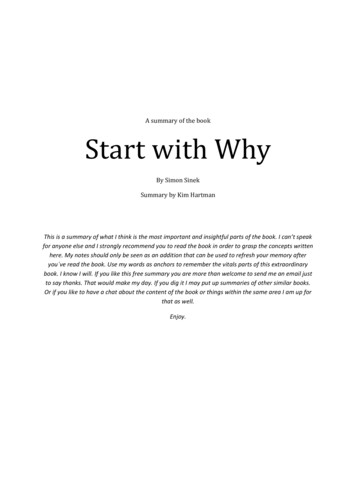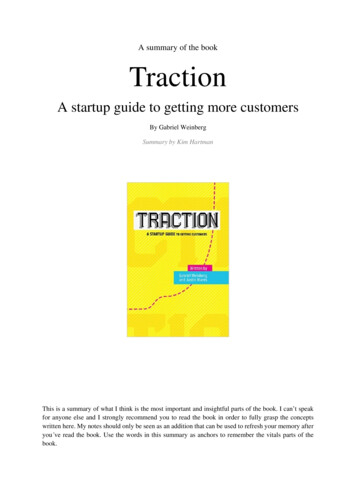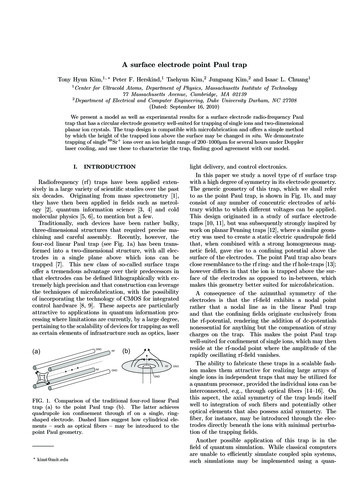
Transcription
A summary of the bookQuietThe power of introverts in a world that can t stop talkingBy Susan CainSummary by Kim HartmanThis is a summary of what I think is the most important and insightful parts of the book. I can’t speakfor anyone else and I strongly recommend you to read the book in order to fully grasp the conceptswritten here. My notes should only be seen as an addition that can be used to refresh your memoryafter you ve read the book. Use the words in this summary as anchors to remember the vitals partsof the book.
More book summaries at www.kimhartman.seContact me at howdy@kimhartman.seContentsIntroduction . 2The North and South of Temperament . 3Chapter 1 . 4The rise of the “mighty likeable fellow” . 4Chapter 2 . 5The myth of charismatic leadership . 5Chapter 3 . 6When collaboration kills creativity . 6Chapter 4 . 8Is temperament destiny? . 8Chapter 5 . 10Beyond temperament The Role of Free Will . 10Chapter 6 . 11Franklin was a politician, but Eleanor spoke out of conscience . 11Chapter 7 . 13Why did Wall Street crash and warren Buffett prosper? . 13Chapter 8 . 16Soft power Asian-Americans and the Extrovert Ideal . 16Chapter 9 . 17When should you act more extroverted than you really are? . 17Chapter 10 . 18The communication gap . 18Chapter 11 . 19On cobblers and generals . 19More book summaries . 211
More book summaries at www.kimhartman.seContact me at howdy@kimhartman.seDescription from amazonIn Quiet, Susan Cain argues that we dramatically undervalue introverts and shows how much we losein doing so. She charts the rise of the Extrovert Ideal throughout the twentieth century and exploreshow deeply it has come to permeate our culture.She also introduces us to successful introverts—from a witty, high-octane public speaker whorecharges in solitude after his talks, to a record-breaking salesman who quietly taps into the power ofquestions.Passionately argued, superbly researched, and filled with indelible stories of real people, Quiet hasthe power to permanently change how we see introverts and, equally important, how they seethemselves.2
More book summaries at www.kimhartman.seContact me at howdy@kimhartman.seIntroductionThe North and South of TemperamentThe Extrovert Ideal:the Extrovert Ideal—the omnipresent belief that the ideal self isgregarious, alpha, and comfortable in the spotlight. The archetypal extrovert prefers action tocontemplation, risk-taking to heed-taking, certainty to doubt. He favors quick decisions, even at therisk of being wrong. She works well in teams and socializes in groups. We like to think that we valueindividuality, but all too often we admire one type of individual—the kind who’s comfortable“putting himself out there.Introverts vs. extroverts: Introverts are drawn to the inner world of thought and feeling,said Jung, extroverts to the external life of people and activities. Introverts focus on the meaningthey make of the events swirling around them; extroverts plunge into the events themselves.Introverts recharge their batteries by being alone; extroverts need to recharge when they don’tsocialize enough.3
More book summaries at www.kimhartman.seContact me at howdy@kimhartman.seChapter 1The rise of the “mighty likeable fellow”How Extroversion Became the Cultural IdealThe Culture of Character:In the Culture of Character, the ideal self was serious,disciplined, and honorable. What counted was not so much the impression one made in public ashow one behaved in private.4
More book summaries at www.kimhartman.seContact me at howdy@kimhartman.seChapter 2The myth of charismatic leadershipThe Culture of Personality, a Hundred Years LaterSuccessful synergy: Successful synergy means a higher ranking for the team than for itsindividual members.How good ideas drown: If we assume that quiet and loud people have roughly the samenumber of good (and bad) ideas, then we should worry if the louder and more forceful people alwayscarry the day. This would mean that an awful lot of bad ideas prevail while good ones get squashed.Yet studies in group dynamics suggest that this is exactly what happens.We perceive talkers as smarter than quiet types: even though grade-pointaverages and SAT and intelligence test scores reveal this perception to be inaccurate. In oneexperiment in which two strangers met over the phone, those who spoke more were consideredmore intelligent, better looking, and more likable.We also see talkers as leaders:The more a person talks, the more other groupmembers direct their attention to him, which means that he becomes increasingly powerful as ameeting goes on. It also helps to speak fast; we rate quick talkers as more capable and appealingthan slow talkers. We don’t need giant personalities to transform companies. We need leaders whobuild not their own egos but the institutions they run.Introverts are good leaders: Introverts are uniquely good at leading initiative-takers.Because of their inclination to listen to others and lack of interest in dominating social situations,introverts are more likely to hear and implement suggestions.Having benefited from the talents of their followers, they are then likely to motivate them to be evenmore proactive. Extroverts, on the other hand, can be so intent on putting their own stamp onevents that they risk losing others’ good ideas along the way and allowing workers to lapse intopassivity.5
More book summaries at www.kimhartman.seContact me at howdy@kimhartman.seChapter 3When collaboration kills creativityThe Rise of the New Groupthink and the Power of Working AloneCreative people as introverts:Creative people tend to be socially poised introverts.They are interpersonally skilled but “not of an especially sociable or participative temperament.”They often describe themselves as independent and individualistic. As teens, many had been shy andsolitary.Introverts are independent: Introverts prefer to work independently, and solitude canbe a catalyst to innovation. As the influential psychologist Hans Eysenck once observed, introversion“concentrates the mind on the tasks in hand, and prevents the dissipation of energy on social andsexual matters unrelated to work.”The New Groupthink: The New Groupthink elevates teamwork above all else. It insists thatcreativity and intellectual achievement come from a gregarious place.The key to exceptional achievement - Deliberate Practice:What’s somagical about solitude? In many fields, Ericsson told me, it’s only when you’re alone that you canengage in Deliberate Practice, which he has identified as the key to exceptional achievement.When you practice deliberately, you identify the tasks or knowledge that are just out of your reach,strive to upgrade your performance, monitor your progress, and revise accordingly. Practice sessionsthat fall short of this standard are not only less useful—they’re counterproductive.They reinforce existing cognitive mechanisms instead of improving them. Deliberate Practice is bestconducted alone for several reasons. It takes intense concentration, and other people can bedistracting. It requires deep motivation, often self-generated. But most important, it involvesworking on the task that’s most challenging to you personally.Only when you’re alone, Ericsson told me, can you “go directly to the part that’s challenging to you. Ifyou want to improve what you’re doing, you have to be the one who generates the move.Multitasking: Scientists now know that the brain is incapable of paying attention to two thingsat the same time. What looks like multitasking is really switching back and forth between multipletasks, which reduces productivity and increases mistakes by up to 50 percent.Peer pressure: If personal space is vital to creativity, so is freedom from “peer pressure.”Group size: Studies have shown that performance gets worse as group size increases: groups ofnine generate fewer and poorer ideas compared to groups of six, which do worse than groups offour.6
More book summaries at www.kimhartman.seContact me at howdy@kimhartman.seOnline collaboration: we’re so impressed by the power of online collaboration that we’vecome to overvalue all group work at the expense of solo thought. We fail to realize that participatingin an online working group is a form of solitude all its own. Instead we assume that the success ofonline collaborations will be replicated in the face-to-face world.The failure of brainstorming: Psychologists usually offer three explanations for the failure of groupbrainstorming.-The first is social loafing: in a group, some individuals tend to sit back and let others do thework.The second is production blocking: only one person can talk or produce an idea at once,while the other group members are forced to sit passively.And the third is evaluation apprehension, meaning the fear of looking stupid in front ofone’s peers.Introvert-extrovert relationships: we should actively seek out symbiotic introvertextrovert relationships, in which leadership and other tasks are divided according to people’s naturalstrengths and temperaments. The most effective teams are composed of a healthy mix of introvertsand extroverts.7
More book summaries at www.kimhartman.seContact me at howdy@kimhartman.seChapter 4Is temperament destiny?Nature, Nurture, and the Orchid HypothesisTemperament” and personality: Psychologists often discuss the difference between“temperament” and “personality.” Temperament refers to inborn, biologically based behavioral andemotional patterns that are observable in infancy and early childhood; personality is the complexbrew that emerges after cultural influence and personal experience are thrown into the mix. Somesay that temperament is the foundation, and personality is the building.The amygdala: serves as the brain’s emotional switchboard, receiving information from thesenses and then signaling the rest of the brain and nervous system how to respond.The more reactive a child’s amygdala, the higher his heart rate is likely to be, the more widely dilatedhis eyes, the tighter his vocal cords, the more cortisol (a stress hormone) in his saliva—the morejangled he’s likely to feel when he confronts something new and stimulating.Inherited introversion: introversion and extroversion, like other major personality traitssuch as agreeableness and conscientiousness, are about 40 to 50 percent heritable. We are born withprepackaged temperaments that powerfully shape our adult personalities.Internalizing parents’ standards of conduct:Many psychologists believe thatchildren develop a conscience when they do something inappropriate and are rebuked by theircaregivers. Disapproval makes them feel anxious, and since anxiety is unpleasant, they learn to steerclear of antisocial behavior. This is known as internalizing their parents’ standards of conduct, and itscore is anxiety.The orchid hypothesis by David Dobbs: This theory holds that many children arelike dandelions, able to thrive in just about any environment. But others, including the high-reactivetypes that Kagan studied, are more like orchids: they wilt easily, but under the right conditions cangrow strong and magnificent.The reactivity of these kids’ nervous systems makes them quickly overwhelmed by childhoodadversity, but also able to benefit from a nurturing environment more than other children do. Inother words, orchid children are more strongly affected by all experience, both positive and negative.High-reactive: High-reactive kids who enjoy good parenting, child care, and a stable homeenvironment tend to have fewer emotional problems and more social skills than their lower-reactivepeers, studies show. Often they’re exceedingly empathic, caring, and cooperative. They work wellwith others. They are kind, conscientious, and easily disturbed by cruelty, injustice, andirresponsibility. They’re successful at the things that matter to them. They don’t necessarily turn intoclass presidents or stars of the school play.8
More book summaries at www.kimhartman.seContact me at howdy@kimhartman.seA high-reactive child’s ideal parent: someone who “can read your cues and respectyour individuality; is warm and firm in placing demands on you without being harsh or hostile;promotes curiosity, academic achievement, delayed gratification, and self-control; and is not harsh,neglectful, or inconsistent.”9
More book summaries at www.kimhartman.seContact me at howdy@kimhartman.seChapter 5Beyond temperament The Role of Free WillAnd the Secret of Public Speaking for IntrovertsAn fMRI machine:can measure which parts of the brain are active when you’re thinking aparticular thought or performing a specific task.Temperament: the footprint of a high- or low-reactive temperament never disappeared inadulthood.Personalities:we can stretch our personalities, but only up to a point. Our inborntemperaments influence us, regardless of the lives we lead.The rubber band theory of personality: We are like rubber bands at rest. We areelastic and can stretch ourselves, but only so much.Introverts are more sensitive:there’s a host of evidence that introverts are moresensitive than extroverts to various kinds of stimulation, from coffee to a loud bang to the dull roar ofa networking event—and that introverts and extroverts often need very different levels ofstimulation to function at their best.Sweet spots: You can organize your life in terms of what personality psychologists call “optimallevels of arousal” and what I call “sweet spots,” and by doing so feel more energetic and alive thanbefore. Your sweet spot is the place where you’re optimally stimulated. People who are aware oftheir sweet spots have the power to leave jobs that exhaust them and start new and satisfyingbusinessesSleep deprivation: introverts function better than extroverts when sleep deprived10
More book summaries at www.kimhartman.seContact me at howdy@kimhartman.seChapter 6Franklin was a politician, but Eleanor spoke out of conscienceWhy Cool Is OverratedThe highly sensitive: tend to be philosophical or spiritual in their orientation, rather thanmaterialistic or hedonistic. They dislike small talk. They often describe themselves as creative orintuitive (just as Aron’s husband had described her). They dream vividly, and can often recall theirdreams the next day. They love music, nature, art, physical beauty.They feel exceptionally strong emotions—sometimes acute bouts of joy, but also sorrow,melancholy, and fear. Highly sensitive people also process information about their environments—both physical and emotional—unusually deeply. They tend to notice subtleties that others miss—another person’s shift in mood, say, or a light bulb burning a touch too brightly.Sensitive people:is sometimes highly empathic. It’s as if they have thinner boundariesseparating them from other people’s emotions and from the tragedies and cruelties of the world.They tend to have unusually strong consciences. They avoid violent movies and TV shows; they’reacutely aware of the consequences of a lapse in their own behavior. In social settings they oftenfocus on subjects like personal problems, which others consider “too heavy.”Guilt: the ones who are likely to be introverts who feel the guiltiest. “Functional, moderate guilt,”writes Kochanska, “may promote future altruism, personal responsibility, adaptive behavior inschool, and harmonious, competent, and prosocial relationships with parents, teachers, and friends.”High-reactive introverts: Among the tools tests researchers use to measure personalitytraits are skin conductance tests, which record how much people sweat in response to noises, strongemotions, and other stimuli. High-reactive introverts sweat more; low-reactive extroverts sweat less.Their skin is literally “thicker,” more impervious to stimuli, cooler to the touch.Acts of devotion: Keltner has tracked the roots of human embarrassment and found thatafter many primates fight, they try to make up. They do this partly by making gestures ofembarrassment of the kind we see in humans—looking away, which acknowledges wrongdoing andthe intention to stop; lowering the head, which shrinks one’s size; and pressing the lips together, asign of inhibition. These gestures in humans have been called “acts of devotion,Embarrassment:“Embarrassment reveals how much the individual cares about the rules thatbind us to one another.”Slow-starters: approximately 20 percent of the members of many species are “slow to warmup,” while the other 80 percent are “fast” types who venture forth boldly without noticing much ofwhat’s going on around them.11
More book summaries at www.kimhartman.seContact me at howdy@kimhartman.seSlow animals are best described as shy, sensitive types. They don’t assert themselves, but they areobservant and notice things that are invisible to the bullies. They are the writers and artists at theparty who have interesting conversations out of earshot of the bullies. They are the inventors whofigure out new ways to behave, while the bullies steal their patents by copying their behavior.”Extroverts vs. Introverts:consider this trade-off: human extroverts have more sexpartners than introverts do—a boon to any species wanting to reproduce itself—but they commitmore adultery and divorce more frequently, which is not a good thing for the children of all thosecouplings. Extroverts exercise more, but introverts suffer fewer accidents and traumatic injuries.Extroverts enjoy wider networks of social support, but commit more crimes.Sensitive people: tend to speak softly because that’s how they prefer others to communicatewith them.Small talk: In most settings, people use small talk as a way of relaxing into a new relationship,and only once they’re comfortable do they connect more seriously. Sensitive people seem to do thereverse. They “enjoy small talk only after they’ve gone deep,” says Strickland. “When sensitivepeople12
More book summaries at www.kimhartman.seContact me at howdy@kimhartman.seChapter 7Why did Wall Street crash and warren Buffett prosper?How Introverts and Extroverts Think (and Process Dopamine) Dif ferentlyReward sensitivity: A reward-sensitive person is highly motivated to seek rewards—from apromotion to a lottery jackpot to an enjoyable evening out with friends. Reward sensitivity motivatesus to pursue goals like sex and money, social status and influence. It prompts us to climb ladders andreach for faraway branches in order to gather life’s choicest fruits.But sometimes we’re too sensitive to rewards. Reward sensitivity on overdrive gets people into allkinds of trouble. We can get so excited by the prospect of juicy prizes, like winning big in the stockmarket, that we take outsized risks and ignore obvious warning signals.Extroverted clients are more likely to be highly reward-sensitive, while the introverts are more likelyto pay attention to warning signals. They’re more successful at regulating their feelings of desire orexcitement. They protect themselves better from the downside.Discipline: The introverts are much better at making a plan, staying with a plan, being verydisciplined.Extroverts seek rewards: Extroverts, in other words, are characterized by their tendencyto seek rewards, from top dog status to sexual highs to cold cash. They’ve been found to havegreater economic, political, and hedonistic ambitions than introverts; even their sociability is afunction of reward-sensitivity, according to this view—extroverts socialize because humanconnection is inherently gratifying.Extroverts seek a rush: Extroverts, in other words, often find themselves in an emotionalstate we might call “buzz”—a rush of energized, enthusiastic feelings. This is a sensation we all knowand like, but not necessarily to the same degree or with the same frequency: extroverts seem to getan extra buzz from the pursuit and attainment of their goals.Dopamine: is the “reward chemical” released in response to anticipated pleasures. Extroverts’dopamine pathways appear to be more active than those of introverts.Delaying gratification:Introverts also seem to be better than extroverts at delayinggratification, a crucial life skill associated with everything from higher SAT scores and income tolower body mass index.Introverts are “geared to inspect” and extroverts “geared to respond.”Extroverts and goals: If you focus on achieving your goals, as reward-sensitive extrovertsdo, you don’t want anything to get in your way—neither naysayers nor the number nine. You speedup in an attempt to knock these roadblocks down. Yet this is a crucially important misstep, because13
More book summaries at www.kimhartman.seContact me at howdy@kimhartman.sethe longer you pause to process surprising or negative feedback, the more likely you are to learnfrom it.Introverts and goals: Introverts, in contrast, are constitutionally programmed to downplayreward—to kill their buzz, you might say—and scan for problems. “As soon they get excited,” saysNewman, “they’ll put the brakes on and think about peripheral issues that may be more important.Introverts seem to be specifically wired or trained so when they catch themselves getting excited andfocused on a goal, their vigilance increases.” Introverts also tend to compare new information withtheir expectations, he says. They ask themselves, “Is this what I thought would happen? Is it how itshould be?”Where extroverts do better:on many kinds of tasks, particularly those performedunder time or social pressure or involving multitasking, extroverts do better. Extroverts are betterthan introverts at handling information overload. Introverts’ reflectiveness uses up a lot of cognitivecapacity, according to Joseph Newman.Cognitive capacity: Extroverts appear to allocate most of their cognitive capacity to the goalat hand, while introverts use up capacity by monitoring how the task is going. But introverts seem tothink more carefully than extroverts, as the psychologist Gerald Matthews describes in his work.Problem-solving: Extroverts are more likely to take a quick-and-dirty approach to problemsolving, trading accuracy for speed, making increasing numbers of mistakes as they go, andabandoning ship altogether when the problem seems too difficult or frustrating. Introverts thinkbefore they act, digest information thoroughly, stay on task longer, give up less easily, and workmore accurately.Attention: Introverts and extroverts also direct their attention differently: if you leave them totheir own devices, the introverts tend to sit around wondering about things, imagining things,recalling events from their past, and making plans for the future. The extroverts are more likely tofocus on what’s happening around them. It’s as if extroverts are seeing “what is” while theirintroverted peers are asking “what if.”Einstein: “It’s not that I’m so smart,” said Einstein, who was a consummate introvert. “It’s that Istay with problems longer.”Flow: The key to flow is to pursue an activity for its own sake, not for the rewards it brings.Although flow does not depend on being an introvert or an extrovert, many of the flow experiencesthat Csikszentmihalyi writes about are solitary pursuits that have nothing to do with reward-seeking:reading, tending an orchard, solo ocean cruising.Flow often occurs, he writes, in conditions in which people “become independent of the socialenvironment to the degree that they no longer respond exclusively in terms of its rewards andpunishments. To achieve such autonomy, a person has to learn to provide rewards to herself.”14
More book summaries at www.kimhartman.seContact me at howdy@kimhartman.seIntroverts and flow: If you’re an introvert, find your flow by using your gifts. You have thepower of persistence, the tenacity to solve complex problems, and the clear-sightedness to avoidpitfalls that trip others up. You enjoy relative freedom from the temptations of superficial prizes likemoney and status. Indeed, your biggest challenge may be to fully harness your strengths.You may be so busy trying to appear like a zestful, reward-sensitive extrovert that you undervalueyour own talents, or feel underestimated by those around you. But when you’re focused on a projectthat you care about, you probably find that your energy is boundless.15
More book summaries at www.kimhartman.seContact me at howdy@kimhartman.seChapter 8Soft power Asian-Americans and the Extrovert IdealQuiet persistence:requires sustained attention—in effect restraining one’s reactions toexternal stimuli. Excellent students seem not only to possess the cognitive ability to solve math andscience problems, but also to have a useful personality characteristic: quiet persistence.16
More book summaries at www.kimhartman.seContact me at howdy@kimhartman.seChapter 9When should you act more extroverted than you really are?The “person-situation” debate: Do fixed personality traits really exist, or do they shiftaccording to the situation in which people find themselves?Free Trait Theory: Little believes that fixed traits and free traits coexist. According to FreeTrait Theory, we are born and culturally endowed with certain personality traits—introversion, forexample—but we can and do act out of character in the service of “core personal projects.” In otherwords, introverts are capable of acting like extroverts for the sake of work they consider important,people they love, or anything they value highly.Core personal projects: According to Little, our lives are dramatically enhanced whenwe’re involved in core personal projects that we consider meaningful, manageable, and not undulystressful, and that are supported by others. When someone asks us “How are things?” we may give athrowaway answer, but our true response is a function of how well our core personal projects aregoing.Behavioral leakage: there’s a limit to how much we can control our self-presentation. This ispartly because of a phenomenon called behavioral leakage, in which our true selves seep out viaunconscious body language: a subtle look away at a moment when an extrovert would have madeeye contact, or a skillful turn of the conversation by a lecturer that places the burden of talking onthe audience when an extroverted speaker would have held the floor a little longer.Suppressing negative emotions:One noteworthy study suggests that people whosuppress negative emotions tend to leak those emotions later in unexpected ways.“People who tend to [suppress their negative emotions] regularly, might start to see the world in amore negative light.”17
More book summaries at www.kimhartman.seContact me at howdy@kimhartman.seChapter 10The communication gapHow to Talk to Members of the Opposite TypeThe need for intimacy: introverts and extroverts are differently social. What psychologistscall “the need for intimacy” is present in introverts and extroverts alike. In fact, people who valueintimacy highly don’t tend to be, as the noted psychologist David Buss puts it, “the loud, outgoing,life-of-the-party extrovert.”They are more likely to be someone with a select group of close friends, who prefers “sincere andmeaningful conversations over wild parties.” Th
Contact me at howdy@kimhartman.se 4 Chapter 1 The rise of the “mighty likeable fellow” How Extroversion Became the Cultural Ideal The Culture of Character: In the Culture of Character, the ideal self was serious, disciplined, and honorable. What counted was not so much the impression one










